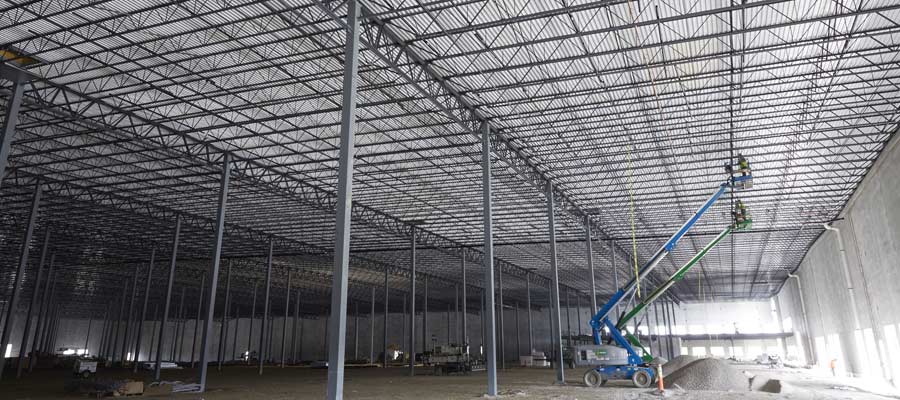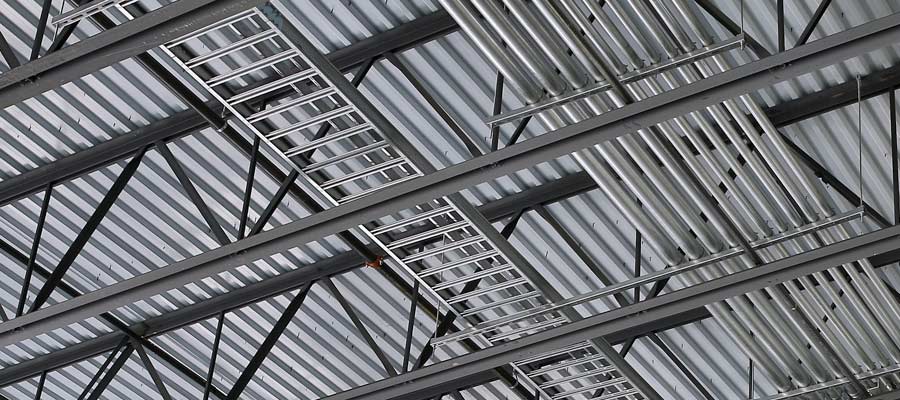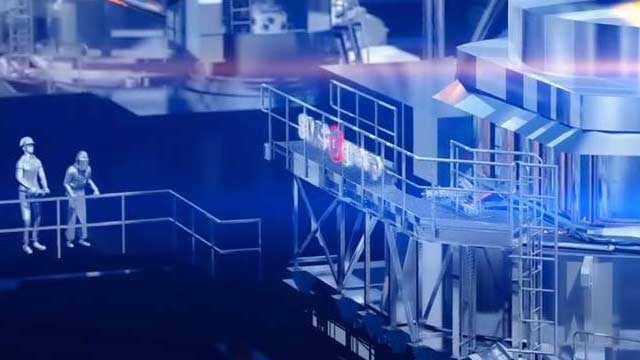
You could call standard steel joists lean, mean fighting machines. You could call them the unsung hero of roofing and flooring systems. One thing is certain: Standard steel joists have been called on for almost a century to be a key component in countless projects.
Standard steel joists have been an integral part of countless construction projects for nearly a century, so they must be doing something right. Take a closer look at the qualities that enable them to enjoy such enduring popularity.
The Steel Joist Institute (SJI) through its member companies has continued to make the specification of standard steel joists simpler for design professionals. A recent specification unified the design requirements for K- and LH-Series joists, which was a long sought-after improvement to simplify the design and specification of those members. The SJI also has developed several design tools and educational webinars to assist design professionals. Kurt Voigt, engineering manager at New Millennium Building Systems, knows why these building workhorses are so common.
“Joists’ economy of overall cost and the flexibility of their use make them practical choices,” Voigt says. “Standard steel joists are typically more cost-effective and far simpler for a designer to specify than steel beams, and they have more capacity and span capabilities than cold-formed steel purlins.”

Single-piece joists can span up to 120 feet and with a bolted splice assembled in the field can span up to 240 feet. As a roof or floor system, they are capable of efficiently supporting nearly any demand imposed upon them.
Why do joists continue to be such a common choice? It boils down to the steel joist’s open-web design, which achieves a series of primary goals: reducing project weight; allowing for seamless integration of mechanical, electrical, and plumbing (MEP) systems; and making erection easier and faster. Individually and combined, those elements save time and money.
The SJI, in its video “An Introduction to the Steel Joist Institute,” says joists are “far superior in weight and costs to their monolithic counterparts.” The open-web design means standard steel joists use less steel than beams, which reduces cost and weight (consequently the joist support system also can be lighter weight), and enables single-piece joists to span up to 120 feet.
“The advantage a joist has in open spans is that you have the steel concentrated in the top and bottom chords, which gives you the structural capacity to achieve a long span without needing a solid, heavy web member that runs the full length of the joist like you do in a beam,” Voigt says.
A further benefit joists offer is ease and efficiency of erection—again thanks to their light weight. Furthermore, when joists arrive at a job site, they are ready to be installed because they have been designed specifically for the project.
“They are very convenient and flexible because they can be fabricated to any length and there are typically sufficient standard joist sizes available in the SJI catalog to accommodate most design loading requirements that an owner may have,” Voigt says. “It’s a product with a standardized and tabulated load capacity but customized to the job by length and all dimensional and connection requirements.”
“Hidden” MEP integration is another time and budget saver that joists offer, he says.
“You can run utilities through the openings between web members rather than below the joists or beams, saving clear height below the joists,” he says. This not only lowers cost, but physically reduces a project’s floor-to-floor height.

MEP integration is seamless with open-web steel joists.
Standard steel joists derive their strength from their efficient design. The top and bottom chords of a joist form the flexural capacity to resist vertical gravity and wind uplift loads while the webs handle the vertical shear forces. Different joist sizes can handle different loads. The trailing number in a joist designation (e.g. the 10 in 30K10) indicates a relative chord size. From that chord size, a flexural capacity can be determined, and the uniform load capacity is then derived for a given span. That is the basis for the standard SJI load tables.
A 30K8 joist has larger chords than a 30K7 joist, thus it has a larger flexural capacity. The uniform load capacity of the chords published in the SJI tables is then used to design the web members along the length of the joist for the vertical shear forces resulting from that load along the span. On a uniformly loaded joist, the shear forces are greatest at the ends of the span, and smallest at the mid-span. The web members are sized accordingly—higher capacity at the ends and smaller capacity near the middle. As the uniform load and/or the span of a joist increases, so do the shear forces, and the required web member sizes.
This efficient design allows joists to use less material, thus lowering cost. “We’re not wasting steel,” Voigt says. “Joists are strong where they need to be and in the in-plane direction they need to be.”
“Bridging is placed between joists to stiffen them to resist lateral movement during erection and to resist the slender bottom chord from buckling out-of-plane under wind uplift loads during service,” Voigt says. “Joists are not designed or intended to carry loads out of the plane of their vertical depth, so they do not have a lot of strength or stiffness in that direction, and bridging is used to supplement the joist in that direction.”
New Millennium delivers added cost savings using shapes in most joists that are cold-formed from hot-rolled steel bands. The steel coils used to make cold-form shapes take up far less inventory space than their merchant counterparts, allowing New Millennium to be more flexible in steel sizes available for projects.
“The chords we form can be nearly always made continuous and have far fewer splices than hot-rolled angle chords, where we have to take two angles, butt them together end to end and weld them together,” Voigt says. “Hot-rolled angles come in various lengths, commonly 60-foot lengths for chord materials, but every 60 feet we are splicing angles together and welding them. Whereas with cold-formed angles we are splicing at 1,000- to 3,000-foot intervals, providing far more continuous chord angles without labor-intensive and costly butt splice welds.
“We’re eliminating that labor-intensive and costly process of splice-welding and piece handling.”

Rogers High School in Rogers, Arkansas, underwent a recent overhaul that included a $16.5 million gymnasium. The ambitious vision for Mountie Arena called for the atmosphere to mimic that of a professional facility. To do that, 85-foot-long, 12-foot-deep double-pitched steel joists were used to create an expansive, arena-like feel.

Hundreds of massive joist girders and thousands of standard steel joists are required to achieve the grand scale of the new, $1.9 billion Steel Dynamics Inc. steel mill in Sinton, Texas. It will be the most technologically advanced steel mill in the country and the largest project SDI has ever undertaken.
Building a better steel experience